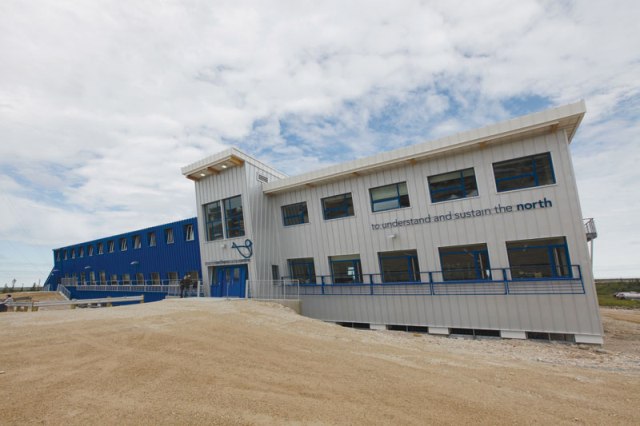This past summer, the Churchill Northern Studies Centre (CNSC) moved into its new 27,800-square-foot facility. Designed for 88 visiting scientists and 12 staff working year-round on sub-arctic scientific research and education, the Centre’s new facility aims to lower utility and operating costs, create a high-performance building to showcase green building engineering design, meet the unique needs of a remote research building in a harsh northern climate, and meet budgetary and time constraints.
Founded in 1976, the CNSC is an independent, non-profit research and education facility located 23 kilometres east of the town of Churchill, Manitoba. The Centre is situated along the Hudson Bay seacoast at the meeting of three major biomes: marine, northern boreal forest, and tundra. To the east lies Wapusk National Park which protects the inland denning area of the polar bear. To the southeast lies the Hudson Bay Lowland, the largest peatland in North America. This complex of biomes creates a tremendous diversity of plants, birds, mammals, and human cultures.
Since the site is remote and exposed with only shrubby tundra vegetation and thin gravelly soils over shallow bedrock, there are no piped municipal services for water, sewer, or gas, and no prospect for any in the future. A one-kilometre power line connects to a Manitoba Hydro electrical service, but it is frequently interrupted by winter weather. Building architectural design team Prairie Architects and M/E design by Enermodal Engineering (a member of the MMM Group Limited) needed to ensure a high degree of reliability and independence for essential services. Here are a few design elements that the team implemented for water and wastewater.
Considering carbon
The old facility had to truck water 20 kilometres from town, then truck back the sewage, creating a significant carbon footprint. In the new facility, every effort was made to decrease carbon emissions. The most significant measure is two large composting systems serving waterless toilets and urinals. Wastewater is treated on-site to tertiary quality by two 5,000-litre biofiltration vessels indoors and two area bed sand dispersal fields outdoors, made of manufactured sand and woodchip-and-sand layers. The daily design flow is only 68 litres per person (L/person), compared to the metered 100-plus L/person in the old building.
Ventilators and composters
An innovative ventilation system using a heat recovery ventilator provides continuous exhaust from the composter, with the toilets themselves acting as the exhaust fans for the washrooms. The system is water-and-energy efficient, keeps the washrooms odour-free, and requires very little maintenance, thanks to a healthy population of red wriggler worms, automatic moistening system, compost tea removal, and the aerobic decomposition process.
Greywater reuse
Lake water is pumped two kilometres to the site in summer and treated with settling, simple cartridge filters, and UV to drinking water quality. Two 13,000-litre tanks can store drinking water trucked from town in winter when the lake is frozen. Untreated lakewater is distributed through separate non-potable water piping to flush toilets, hose bibs, and drain trap primers to reduce the need for drinking water. Drainwater heat exchangers recover heat from the showers and lavatories to preheat domestic hot water.
This type of innovative, yet simple design could be applied to a variety of building types in remote northern locations. It meets the needs of the occupants for a modern building with all the anticipated amenities and services, while providing significant energy and water savings for the owner and environment.
Richard Lay, P.Eng, is the senior mechanical designer at Enermodal Engineering, a member of the MMM Group Limited.














For Polaris on Little Cornwallis Island with 1700 feet of permaforst, we used vacuum toilet systems, resulting in a 92% reduction in water demand. The down side was noise tranmission through the residential modules (with consideration there was 12 hours shoft work).